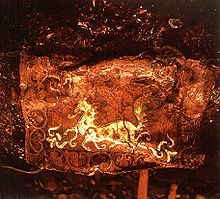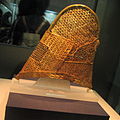- Cheonmachong
-
Cheonmachong 
The heavenly horseKorean name Hangul 천마총 Hanja 天馬塚 Revised Romanization Cheonmachong McCune–Reischauer Ch'ŏnmach'ong Cheonmachong, formerly Tomb No.155, is a tumulus located in Gyeongju, South Korea. The tomb was excavated in 1973 and is believed to date probably from the fifth century but perhaps from the sixth century CE. The tomb was for an unknown king of the Silla Kingdom.[1]
The tomb, in typical Silla style, is a wood-lined chamber running east to west and is covered in a mound of boulders and earth.[2] This kind of tomb is said to follow the pattern of a tomb in Pazyryk, Russia.[3] The tomb is 47 metres in diameter, 157 metres in circumference, and 12.7 metres in height.
The chamber of the tomb contained a lacquered wooden coffin which had burial goods placed around it.[1] A total of 11,500 artifacts were recovered from the tomb. The name of the tomb derives from a famous painting of a white horse which is depicted on a birch bark saddle flap, also referred to as a mud-guard.[3] The horse, a Cheonma (Korean pegasus), has eight legs and is depicted with wings on its feet. This painting is a rare example of extant Silla painting and indicates a strong influence by the Korean Goguryeo Kingdom.[4] The burial of horse trappings and the sacrifice of a horse with the king shows the importance of horse culture in Silla society and indicates the central role of the king in shamanism practiced by the people.[3] The other side of the saddle flaps depict horsemen and the phoenix. The tomb also yielded many other treasures including a gold crown and a gold girdle, both replete with jade comma-shaped beads. These trappings of royalty indicate that a king was buried in the tomb. Additionally, the fact that the girdle in the Heavenly Horse Tomb is similar to a girdle found in the Gold Crown Tomb and the use of the dragon motif in gold plates which matches treasures in the Baekje King Muryeong also indicate a royal king was interred in the tomb.[3] Besides the crown and girdle, the chamber also held gold bracelets and gold rings for every finger of the buried king.[2] The tomb also contained a chest full of burial goods which including the aforementioned painted saddle flap, and also iron kettles, pottery, bronze vessels, lacquerware, saddles, and a 98 centimeter long sword.[2][4]
Contents
Gallery
-
Cheonmado (Painting of the Heavenly Horse), No. 207 National Treasure
-
Gold crown of Silla, No. 188 National Treasure
Notes
- ^ a b Barbara Ann Kipfer, Encyclopedic Dictionary of Archaeology, p.232
- ^ a b c Sarah Milledge Nelson, The Archaeology of Korea, p.250
- ^ a b c d Richard Rutt, Keith L. Pratt, Korea: A Historical and Cultural Dictionary, p.165
- ^ a b www.orientalarchitecture.com
References
- Kim, Jeong-gi et al.
- 1974 Cheonmachong Balguljosa Bogoseo [Cheonmachong Excavation Site Report]. Office of Cultural Properties, Seoul.
See also
- History of Korea
- Silla
- Korean art
- Crown of Silla
- Gold girdle of Korea
External links
Coordinates: 35°50′16″N 129°12′45″E / 35.83778°N 129.2125°E
Wikimedia Foundation. 2010.




